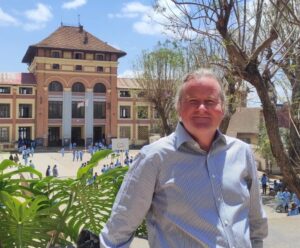 Charles A Dana Professor of Physics
Charles A Dana Professor of Physics
Physics Department
Lafayette College
Hugel Science Center 026
701 Sullivan Road
Easton, PA 18042
Email: niced@lafayette.edu
Phone: +1-610-330-5204
Office Hours: Wednesday 2:30-3:30,
Thursday 11:15-12:00 & 2:30-3:00
(Photo: Lycée Andohalo, Antananarivo, Madagascar; see LIME.)
My students and I use radio telescopes to study pulsars—rapidly rotating neutron stars—for a variety of astrophysical applications, including the detection and characterization of long-wavelength gravitational waves. Much of this work is done as part of the NANOGrav Physics Frontiers Center. Our work is supported by the National Science Foundation.
We and our NANOGrav collaborators recently found strong evidence that our Galaxy is permeated by a background of gravitational waves. These waves periodically stretch and shrink the spacetime around the Earth over periods of many years. They likely originate from pairs of supermassive black holes orbiting each other in distant galaxies. This finding came from fifteen years of very high precision data collected at three of the world’s largest radio telescopes. You can read more here:
- Lafayette News:
Scientists Use Exotic Stars to Tune into Hum from Cosmic Symphony - New York Times:
The Cosmos Is Thrumming With Gravitational Waves, Astronomers Find - Washington Post:
In a Major Discovery, Scientists Say Space-time Churns Like a Choppy Sea - More press coverage is listed at the bottom of this page:
NANOGrav 15-Year News Release - Our research papers are here:
Astrophysical Journal Letters NANOGrav 15-Year Focus Issue
There are some previous articles about our research at Lafayette here and here and here.
We were frequent users of the Arecibo Observatory. After a series of cable failures, the observatory structure collapsed in December 2020. Pulsar research at Lafayette continues to use other observatories, such as the Green Bank Telescope.
Personal: My wife, Marian Wentworth, is CEO of Management Sciences for Health, a global nonprofit organization that works with communities and governments to strengthen health systems serving the world’s most vulnerable populations. We have two daughters, one working in public education policy research and advocacy, the other a postdoctoral fellow in mathematics, both ballet dancers in their spare time.
